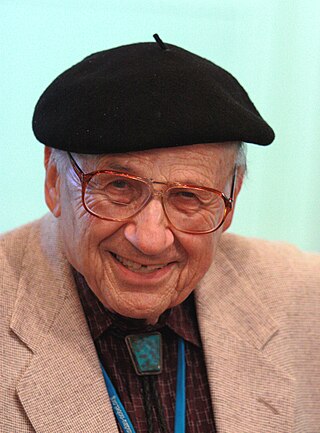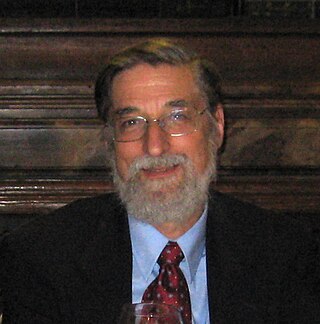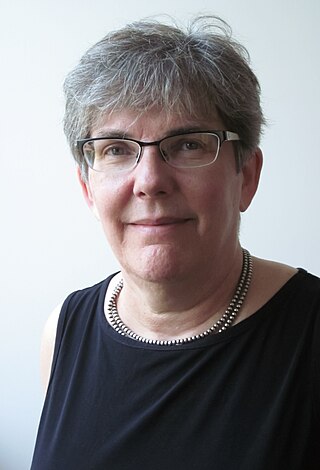Related Research Articles
The quasispecies model is a description of the process of the Darwinian evolution of certain self-replicating entities within the framework of physical chemistry. A quasispecies is a large group or "cloud" of related genotypes that exist in an environment of high mutation rate, where a large fraction of offspring are expected to contain one or more mutations relative to the parent. This is in contrast to a species, which from an evolutionary perspective is a more-or-less stable single genotype, most of the offspring of which will be genetically accurate copies.

Theoretical chemistry is the branch of chemistry which develops theoretical generalizations that are part of the theoretical arsenal of modern chemistry: for example, the concepts of chemical bonding, chemical reaction, valence, the surface of potential energy, molecular orbitals, orbital interactions, and molecule activation.

John Clarke Slater was a noted American physicist who made major contributions to the theory of the electronic structure of atoms, molecules and solids. He also made major contributions to microwave electronics. He received a B.S. in Physics from the University of Rochester in 1920 and a Ph.D. in Physics from Harvard in 1923, then did post-doctoral work at the universities of Cambridge (briefly) and Copenhagen. On his return to the U.S. he joined the Physics Department at Harvard.

David Jonathan Gross is an American theoretical physicist and string theorist. Along with Frank Wilczek and David Politzer, he was awarded the 2004 Nobel Prize in Physics for their discovery of asymptotic freedom. Gross is the Chancellor's Chair Professor of Theoretical Physics at the Kavli Institute for Theoretical Physics (KITP) of the University of California, Santa Barbara (UCSB), and was formerly the KITP director and holder of their Frederick W. Gluck Chair in Theoretical Physics. He is also a faculty member in the UCSB Physics Department and is currently affiliated with the Institute for Quantum Studies at Chapman University in California. He is a foreign member of the Chinese Academy of Sciences.
Shamit Kachru is a theoretical physicist, a professor of physics at Stanford University, and the Wells Family Director of the Stanford Institute for Theoretical Physics. He served as the Stanford Physics Department Chair from 2018 to 2021.

Walter Kohn was an Austrian-American theoretical physicist and theoretical chemist. He was awarded, with John Pople, the Nobel Prize in Chemistry in 1998. The award recognized their contributions to the understandings of the electronic properties of materials. In particular, Kohn played the leading role in the development of density functional theory, which made it possible to calculate quantum mechanical electronic structure by equations involving the electronic density. This computational simplification led to more accurate calculations on complex systems as well as many new insights, and it has become an essential tool for materials science, condensed-phase physics, and the chemical physics of atoms and molecules.

Bertrand I. Halperin is an American physicist, former holder of the Hollis Chair of Mathematicks and Natural Philosophy at the physics department of Harvard University.

Leo Philip Kadanoff was an American physicist. He was a professor of physics at the University of Chicago and a former President of the American Physical Society (APS). He contributed to the fields of statistical physics, chaos theory, and theoretical condensed matter physics.
Stuart Alan Rice is an American theoretical chemist and physical chemist. He is well known as a theoretical chemist who also does experimental research, having spent much of his career working in multiple areas of physical chemistry. He is currently the Frank P. Hixon Distinguished Service Professor Emeritus at the University of Chicago. During his tenure at the University of Chicago, Rice has trained more than 100 Ph.D. students and postdoctoral researchers. He received the National Medal of Science in 1999.
Jeffrey Goldstone is a British theoretical physicist and an emeritus physics faculty member at the MIT Center for Theoretical Physics.
Daniel Amihud Lidar is the holder of the Viterbi Professorship of Engineering at the University of Southern California, where he is a Professor of Electrical Engineering, Chemistry, Physics & Astronomy. He is the Director and co-founder of the USC Center for Quantum Information Science & Technology (CQIST) as well as Scientific Director of the USC-Lockheed Martin Quantum Computing Center, notable for his research on control of quantum systems and quantum information processing.
In physics, a quantum is the minimum amount of any physical particle that has entropy. The fundamental notion that a physical property can be "quantized" is referred to as "the hypothesis of quantization". This means that the magnitude of the physical property can take on only discrete values consisting of integer multiples of one quantum.

David R. Nelson is an American physicist, and Arthur K. Solomon Professor of Biophysics, at Harvard University.
Raphael Bousso is a theoretical physicist and cosmologist. He is a professor at the Berkeley Center for Theoretical Physics in the Department of Physics, UC Berkeley. He is known for the Bousso bound on the information content of the universe. With Joseph Polchinski, Bousso proposed the string theory landscape as a solution to the cosmological constant problem.
Naomi Shauna Ginsberg, is an electrical engineer, physicist, and scientist. She is currently an associate professor of chemistry at the University of California, Berkeley.
Lowell S. Brown is an American theoretical physicist, a retired Staff Scientist and Laboratory Fellow at Los Alamos National Laboratory, and Professor Emeritus of physics at University of Washington. He was a student of Julian Schwinger at Harvard University and a recipient of the John Simon Guggenheim Memorial Foundation Fellowship. Brown authored a book on Quantum Field Theory that has received over 5,000 citations, and he has authored or co-authored over 150 articles that have accumulated over 11,000 citations.

Heidi Marie Schellman is an American particle physicist at Oregon State University (OSU), where she heads the Department of Physics. She is an expert in Quantum chromodynamics.
Katherine Birgitta Whaley is a Professor of Chemistry at the University of California Berkeley and a senior faculty scientist in the Division of Chemical Sciences at Lawrence Berkeley National Laboratory. At UC Berkeley, Whaley is the Director of the Berkeley Quantum Information and Computation Center, a member of the executive board for the Center for Quantum Coherent Science, and a member of the Kavli Energy Nanosciences Institute. At Lawrence Berkeley National Laboratory, Whaley is a member of the Quantum Algorithms Team for Chemical Sciences in the research area of resource-efficient algorithms.
Monika Schleier-Smith is an American experimental physicist studying many-body quantum physics by precisely assembling systems of ultracold atoms. These atomic, molecular, and optical physics (AMO) engineered systems have applications in quantum sensing, coherent control, and quantum computing. Schleier-Smith is an Associate Professor of Physics at Stanford University, a Sloan Research Fellow, and a National Science Foundation CAREER Award recipient. Schleier-Smith also serves on the board of directors for the Hertz Foundation.
Catherine Kallin is a Canadian theoretical quantum condensed matter physicist whose research topics have included spin wave theory, the quantum Hall effect, frustrated antiferromagnets, chirality in superconductors, and high-temperature superconductivity. She is a professor emerita of physics and astronomy at McMaster University.
References
- 1 2 "Memorial Seat". Chemistry.org.il. Archived from the original on 2013-10-07. Retrieved 2013-01-11.
- ↑ Emmanuel Tannenbaum and Eric Heller (2001). "Semiclassical quantization using invariant tori: a gradient-descent approach". The Journal of Physical Chemistry A. 105 (12): 2803–2813. Bibcode:2001JPCA..105.2803T. doi:10.1021/jp004371d.
- ↑ Emmanuel Tannenbaum and Eric Deeds and E.I. Shakhnovich (2004). "Semiconservative replication in the quasispecies model". Physical Review E. 69 (6): 061916. arXiv: cond-mat/0309642 . Bibcode:2004PhRvE..69f1916T. doi:10.1103/PhysRevE.69.061916. PMID 15244626. S2CID 1532122.
- ↑ Choosing Sex Is a Matter of Time (E.D. Tannenbaum's featured work at American Physical Society) http://psychcentral.com/news/archives/2006-03/aps-bpm012706.html
- ↑ Michael Schirber, APS Focus: "Why sleep?" (An account of E.D. Tannenbaum's work on the theory of sleep) http://physics.aps.org/story/v21/st1
- ↑ Stealth Technology: E.D. Tannenbaum. arXiv : 1208.2377
- ↑ The Alon Fellowship. "Allon Fellowships for Outstanding Young Researchers | the Council for Higher Education of Israel". Archived from the original on 2013-01-29. Retrieved 2012-12-23.
- ↑ National Institutes of Health Fellowship: E.D. Tannenbaum (Harvard University). http://report.nih.gov/award/index.cfm?ot=&fy=2005&state=&ic=NIGMS&fm=&orgid=3212901&distr=&rfa=&view=data&pil=T#tabpi